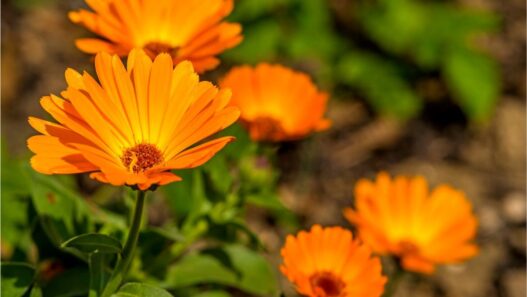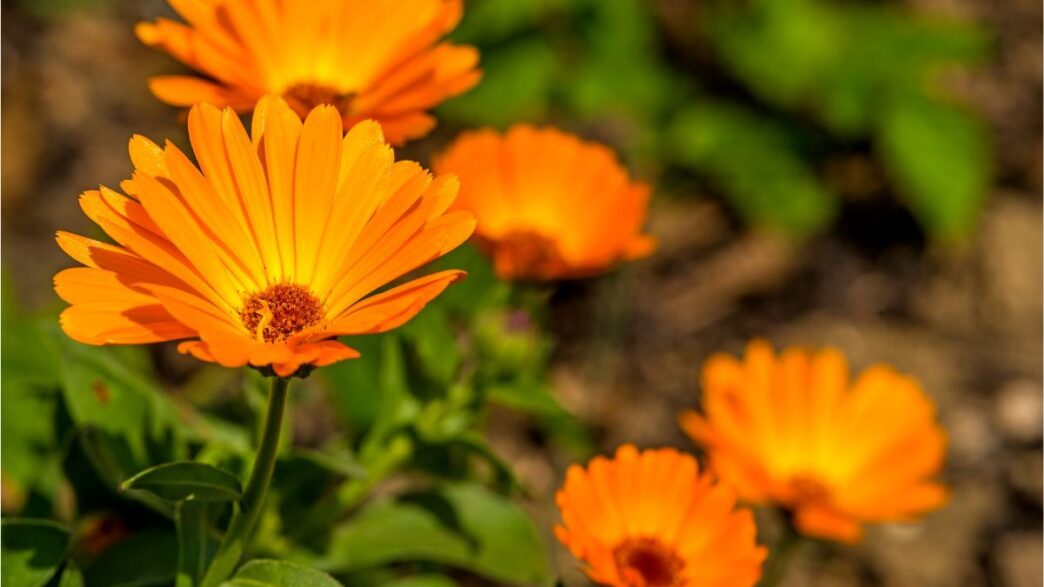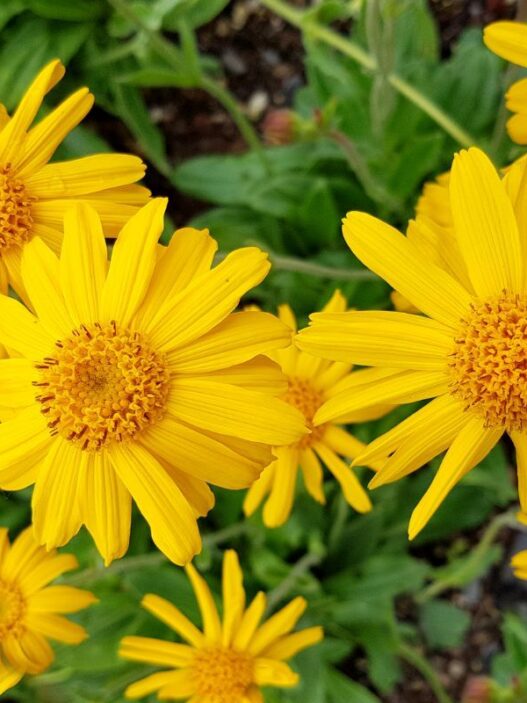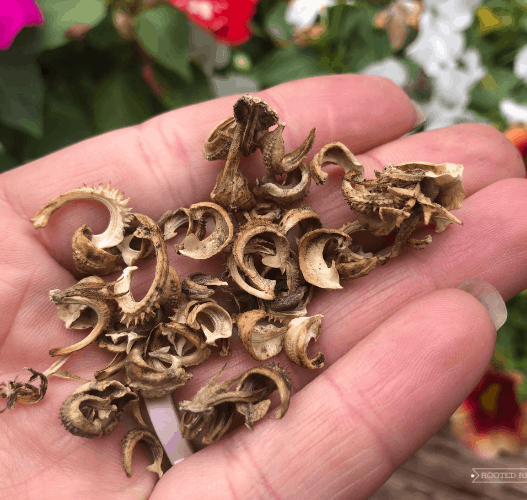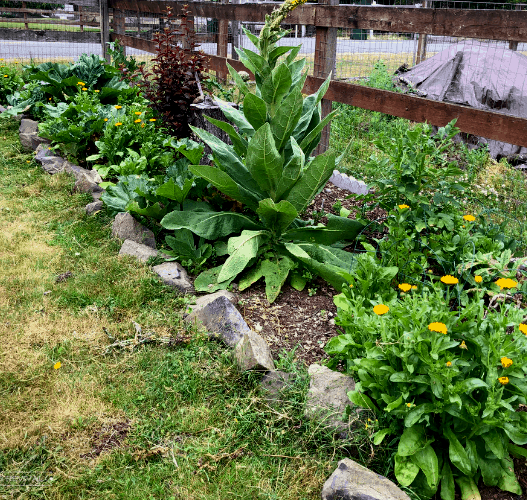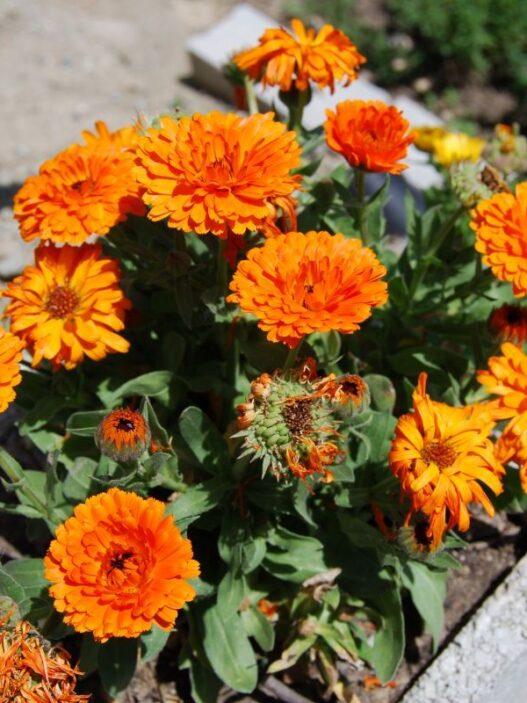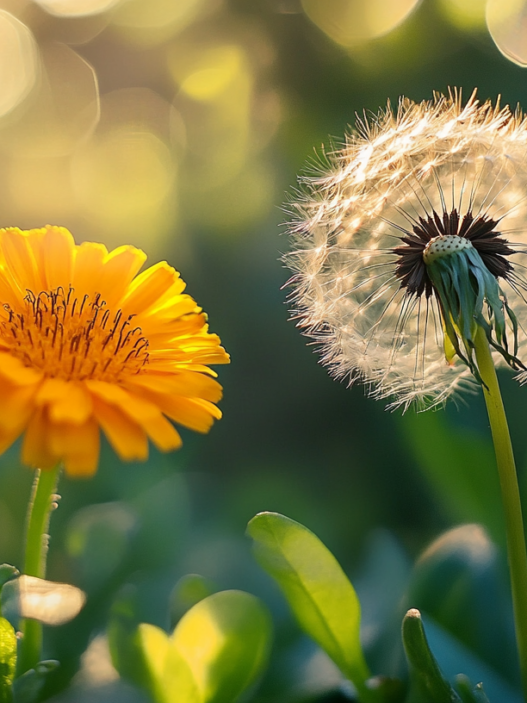Calendula is a perennial plant, which means that it survives for many years, producing new growth from season to season.
Usually, Calendula flower season lasts from spring to fall, so you get to enjoy the colorful view most of the year. In the US, you can expect your calendula to flower from May to September.
I’ve been growing calendula for many moons! (I feel old). So I’ve put together this guide that deals with the most important things I’ve learned, which include:
- The Calendula flower season in detail – what to expect
- Calendula flower uses (and at what time of year)
- Calendula flower varieties
- Calendula flower planting guide, and what time of the year to plant them

Calendula Flower Season
Calendula officinalis is a marvelous plant species that provides a display of yellow and orange blooms from spring to fall! Luckily, it’s a hardy plant that can tolerate a bit of frost without dying. (Hard-to-kill flowers work great in my garden!)
In fact, it may even continue blooming through winter if the climate is moderate enough. Yet, in areas with high temperatures, your Calendula might stop blooming.
Naturally, Calendula produces blooms from June to September when sown in spring and from May to July when sown in autumn.
Typically, the blooming starts 45 to 60 days after planting the seeds. Throughout its growing season, Calendula flowers keep blooming continuously.
What’s amazing about Calendula is that it keeps producing mesmerizing flowers as long as you keep dead-heading.
This means that the more flowers you cut, the more new blooms the plants produce.
Gardeners often use Calendula as a companion plant to attract pollinators to their other crops. However, there’s more to this lovely flower than just good looks.
Calendula Flower Uses
Most of the Calendula plant is edible. The flower petals always add a gorgeous touch as a garnish to any plate.
In general, herbalists use the whole flower head for various medicinal and cosmetic purposes. From petals to the base itself, all parts of the calendula flower contain useful substances.
Usually, the more sticky the base of the Calendula flower (involucre) is, the better effect it has.
Calendula has many internal and external healing properties. So, take a look at some of the flower uses and benefits.
- It’s packed with antioxidants that reduce oxidative stress and boost your bodily functions.
- It has anti-inflammatory properties that help relieve gastric ulcers and improve the digestion process.
- Calendula oils and tinctures have the ability to treat wounds and skin ulcers by increasing the production of collagen.
- The antioxidant substances in Calendula may have a great effect in fighting cancer, especially melanoma.
- It has antimicrobial and antifungal properties.
- Creams and ointments made from Calendula have substantial effects in stimulating skin elasticity and enhancing hydration.
- The antioxidants in Calendula can improve heart health and reduce the risk of heart attacks.
Calendula Flower Varieties
Calendula usually produces flowers ranging in color from yellow to bright orange (some even have peach shades). These flowers often have a diameter of 2–3 inches.
You might find a Calendula variety with single flowers, while another variety may have double flowers.
Single and double don’t refer to the number of flowers but to the layers of petals.
Single flowers are more attractive to pollinators with their open center. On the other hand, double flowers have a more closed center and a larger number of petals.
Although the species “Calendula officinalis” has over 100 cultivars, all of them are edible and possess medicinal properties.
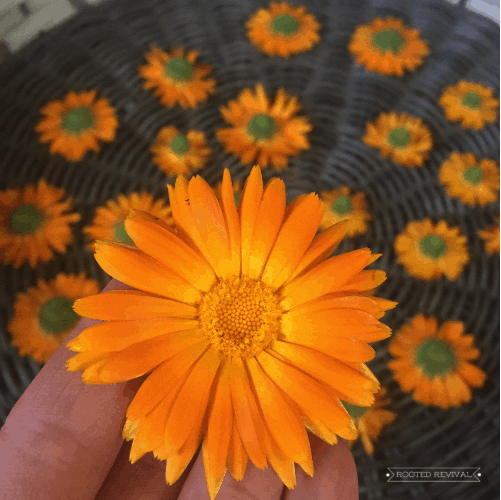
Calendula Flower Planting Guide
Calendula is easy to grow and doesn’t have many requirements to thrive. It offers you a great opportunity to add a splash of color to your garden and enjoy the beautiful blooms.
| Quick Facts About Calendula | |
| Common Name | Calendula, pot marigold |
| Botanical Name | Calendula officinalis |
| Family | Asteraceae |
| Type | Perennial, annual |
| Hardiness USDA Zones | 2A–11B – Annual planting9–11 – Perennial planting |
| Maturity Size | One to two feet |
| Maturity Duration | 45–60 days seeds to flowers |
| Plant Spacing | 24–36 apart |
| Soil Type and pH | Well-draining soil with neutral pH of 6–7 |
| Sunlight | Full sun/partial shade |
| Bloom Time | Spring to fall |
| Flower Color | Yellow, orange, red, white, and pink |
| Optimal Growth Temperature | 75°F |
| Maintenance | Low |
Calendula Planting Care
Calendula is native to the Mediterranean region and southern Europe. Gardeners have been planting it for centuries.
Although it’s known as “pot marigold,” it doesn’t come from the same genus as ordinary marigold.
However, both flowers are natural insect repellents in vegetable gardens when planted as companion plants. Plus, they attract butterflies, bees, and many other pollinators.
Here’s how to care for Calendula.
1. Water
After sowing the seeds, Calendula needs plenty of water. That’s why you should water your plants more often right after planting.
Once your Calendula plants are well-established, you don’t need to water them as much. One to one and a half inches of water every week is more than enough.
That said, avoid overwatering your Calendula. After all, such a plant can tolerate drought quite impressively.
2. Soil
Like many plant varieties under the daisy family, Calendula requires well-draining soil that’s rich in organic components.
As for acidity, this plant can tolerate most levels. However, it thrives the most in neutral soil with a pH of 6–7.
3. Sun
The optimal light condition for growing Calendula is full sun to partial shade.
While the plant enjoys the sun during the day, it prefers a bit of shade during the midday heat. That’s especially during the summer months.
4. Temperature and Humidity
Calendula can be heat sensitive, growing best in areas with a moderate climate. That said, while it may tolerate it to some extent, severe frost can damage the plant too.
That’s why experts recommend using mulch and a frost blanket to shield the plant from frost.
5. Fertilizer
If your soil is already rich in nutrients, you might not need to use fertilizers to grow Calendula. Otherwise, consider using a balanced, water-soluble fertilizer.
